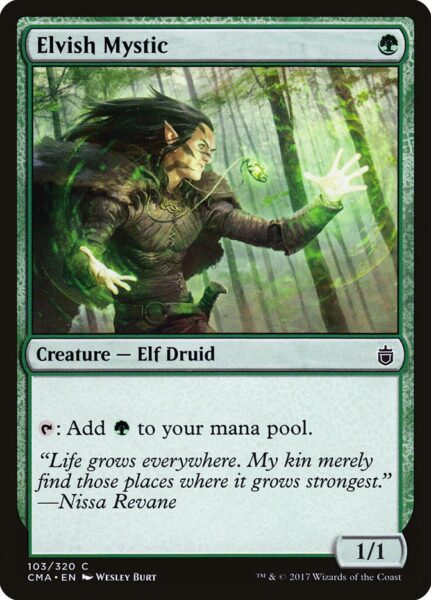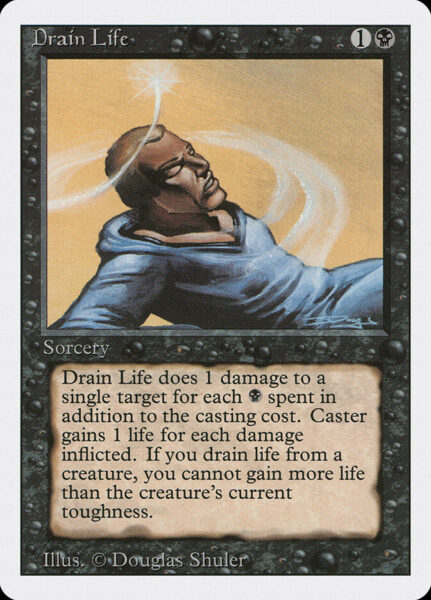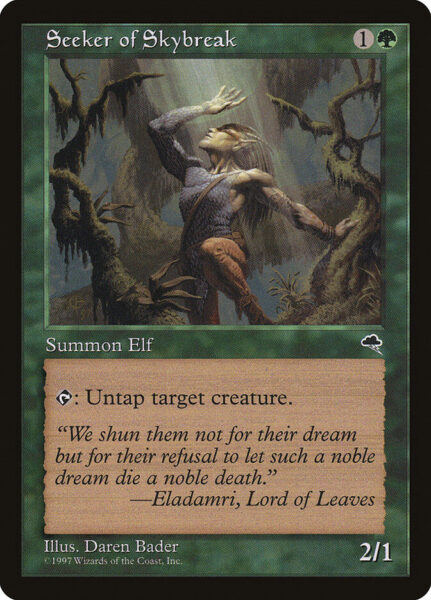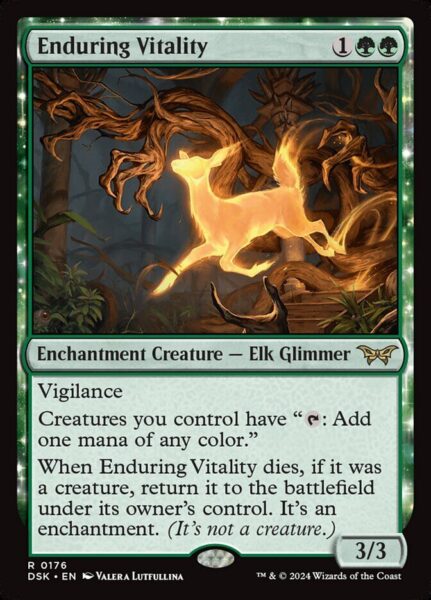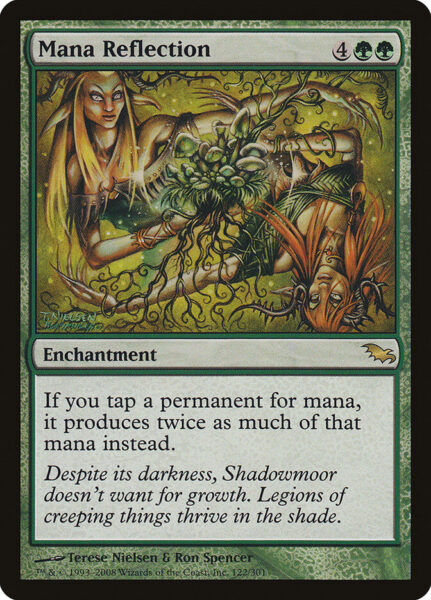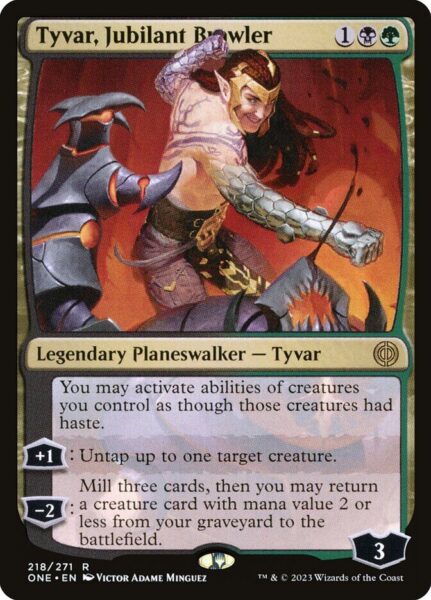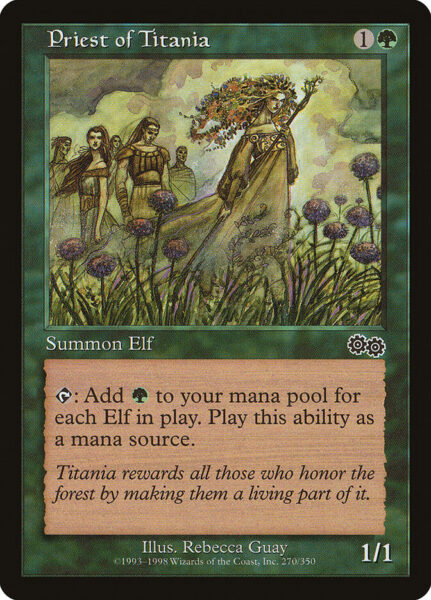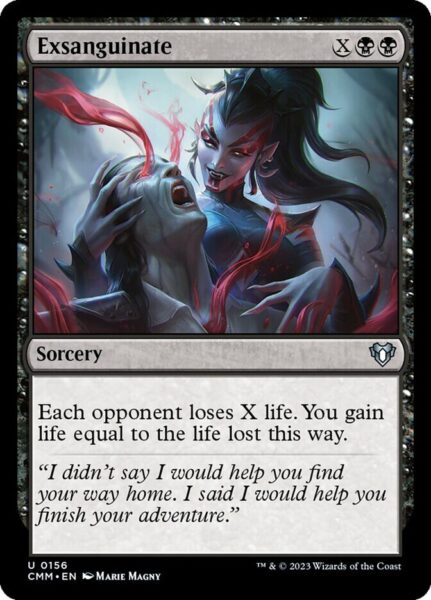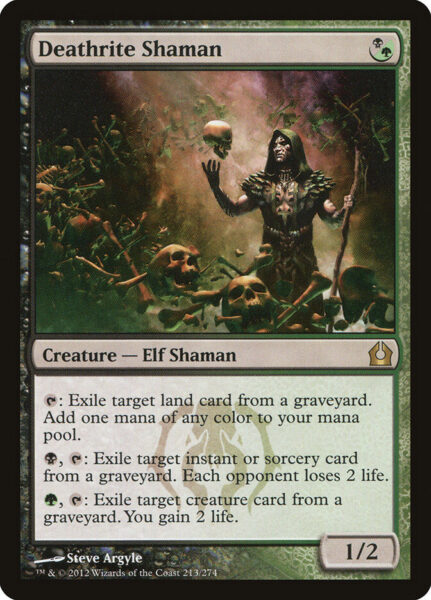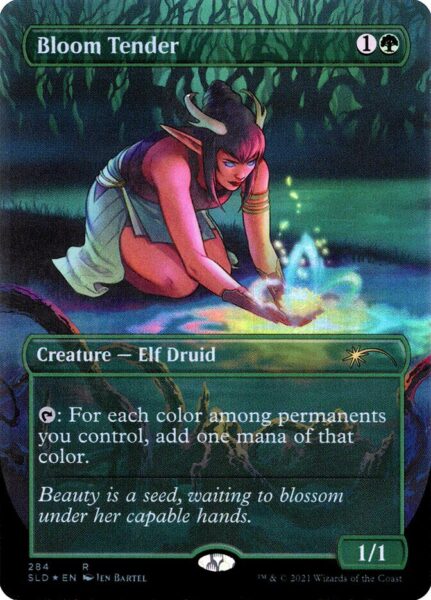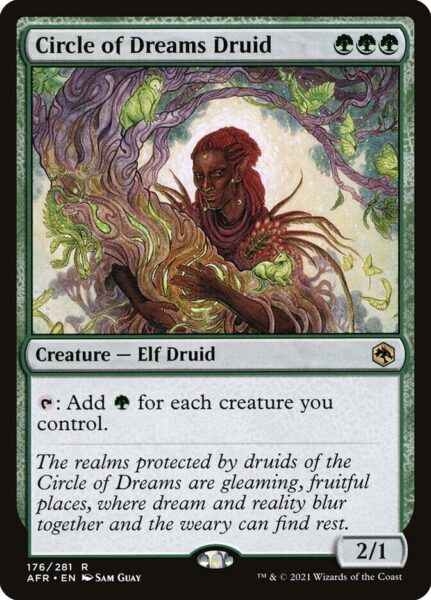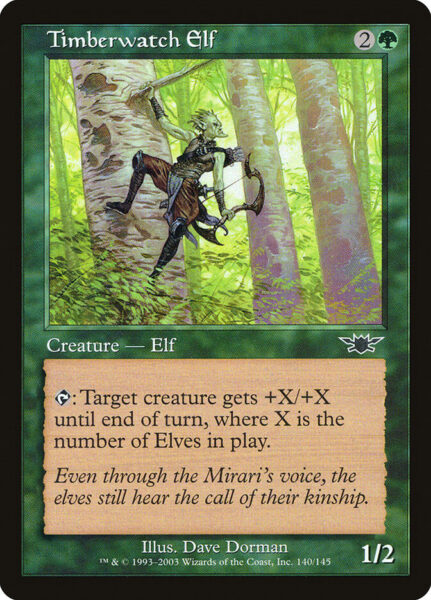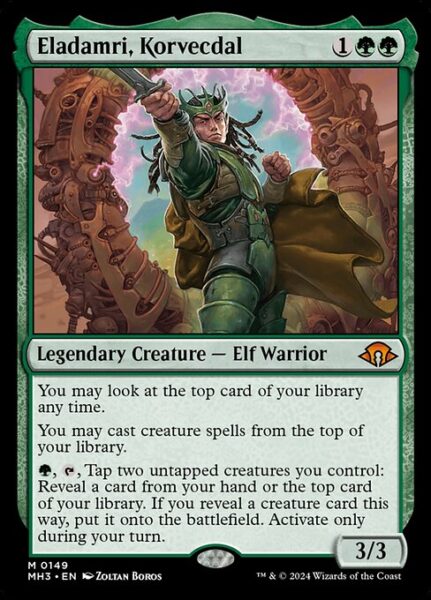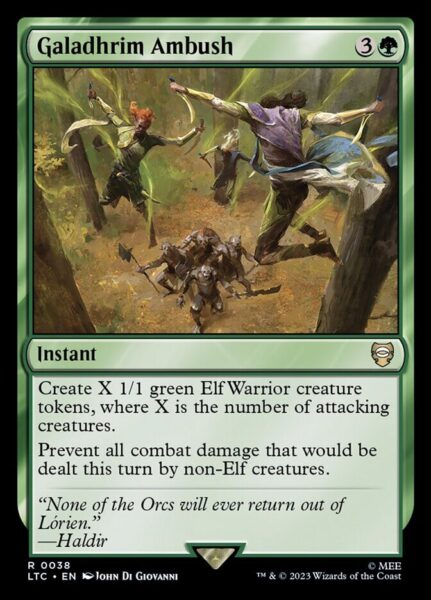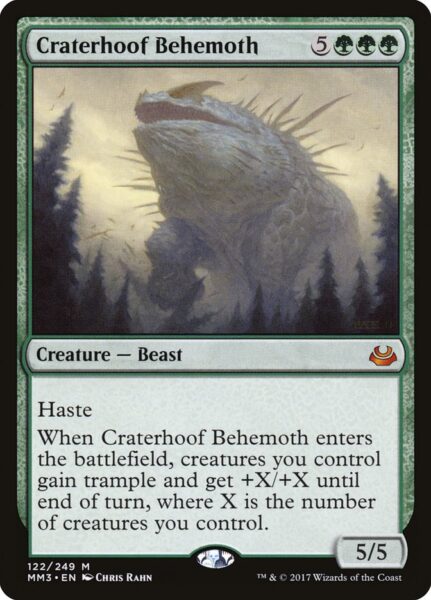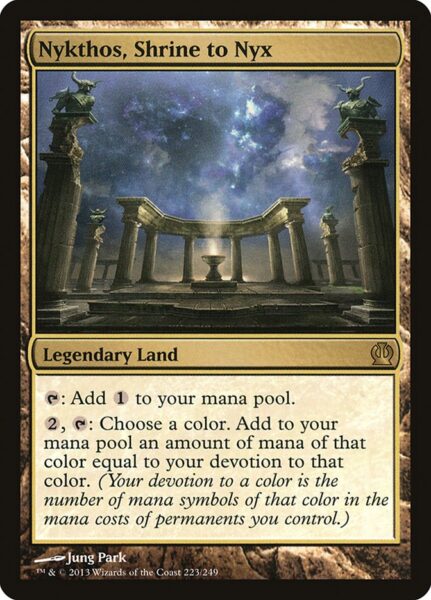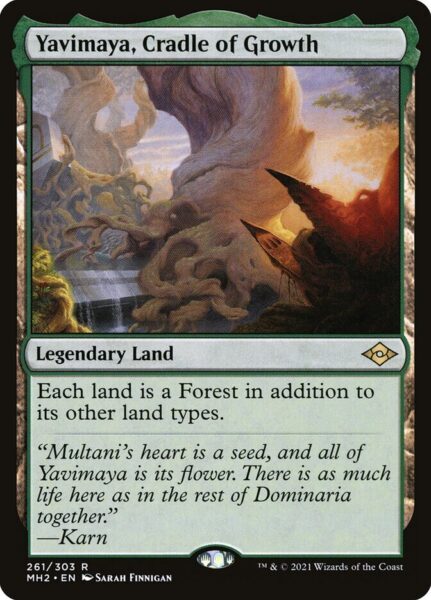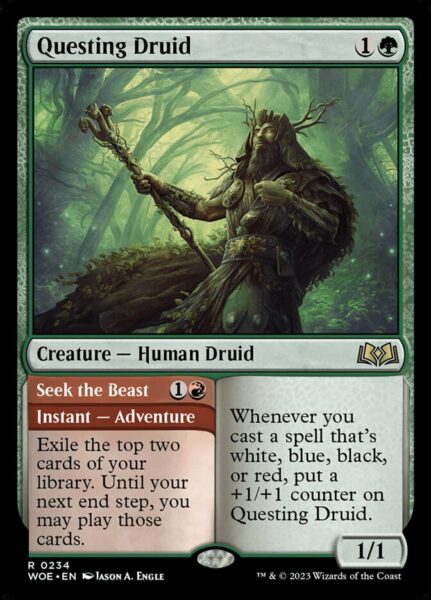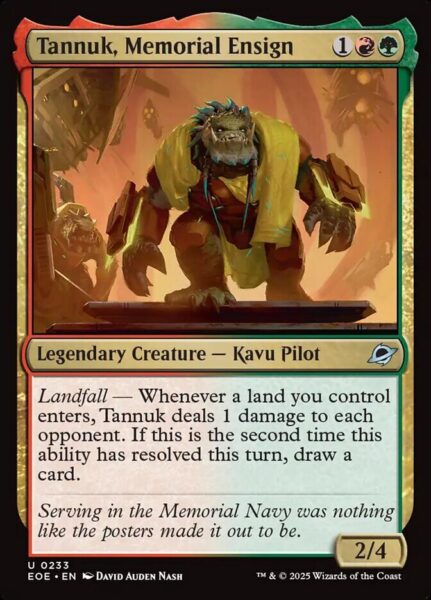by Johnny Cycles, February 28th, 2025
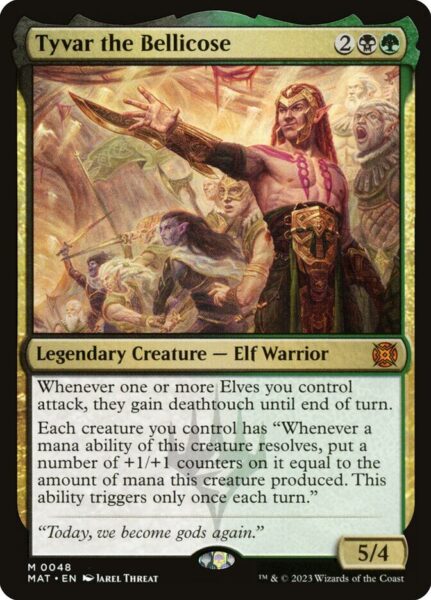
Love Elves, but don’t like winning via combat? Long for the days of the OG Elfball strategy, which splashed for Fireball? Tired of not getting to play all of those sweet Black and Golgari Elves Wizards keeps printing? Or maybe you enjoy taking lowly mana dorks and transforming them into lethal threats? If so, check out my Tyvar the Bellicose deck!
Deck List – Golgari Elfball with Tyvar the Bellicose
| Tyvar the Bellicose |
Creatures (37)
| Deathrite Shaman | |
| Elvish Mystic | |
| Fyndhorn Elves | |
| Llanowar Elves | |
| Bloom Tender | |
| Fanatic of Rhonas | |
| Gyre Sage |
| Beast Whisperer | |
| Canopy Tactician | |
| Citanul hierophants | |
| Dionus, Elvish Archdruid | |
| Lathril, Blade of the Elves | |
| Nylea, God of the Hunt | |
| Wirewood Channeler | |
| Seedborn Muse |
Planeswalkers (2)
| Tyvar, Jubilant Brawler | |
| Tyvar Kell |
Enchantments (8)
| Cryptolith Rite | |
| Primal Rage |
| Branching Evolution | |
| Phyrexian Arena | |
| Elven Chorus | |
| Leyline of Abundance | |
| Doubling Season | |
| Mana Reflection |
Instants (14) with 3 mfdcs
Sorceries (4)
| Drain Life | |
| Exsanguinate | |
| Profane Command | |
| Genesis Wave |
Lands (34) with 3 mfdcs
| Bloodstained Mire | |
| Bojuka Bog | |
| Command Tower | |
| Darkbore Pathway | |
| Deathcap Glade | |
| Deserted Temple | |
| Drannith Ruins | |
| Karn’s Bastion | |
| Llanowar Wastes |
| Overgrown Tomb | |
| Path of Ancestry | |
| Scavenger Grounds | |
| Twilight Mire | |
| Underground Mortuary | |
| Undergrowth Stadium | |
| Urborg, Tomb of Yawgmoth | |
| Wirewood Lodge | |
| Woodland Cemetery | |
| Forest (11) | |
| Swamp (5) |
Original Deck Idea/Deck Tech
Primary Game Plan
We’re looking to grow our mana dorks to massive proportions and either swing in for lethal in one, deathtouch-fueled attack, or make a ton of mana and resolve a Drain Life effect to jank our opponent out. And sometimes we do both!

Tyvar the Bellicose is the centerpiece of this dual strategy. He grows our mana dorks each time we tap them for mana and he gives them all deathtouch when it’s time for us to attack.
Of course, we don’t want to just play him fairly. A deck full of mana dorks that grow once on our turn is fun and all, but it’s a slow, underpowered strategy that gives our opponent time to kill us before our army of former 1/1s can finish them off.
Thus, we’re playing ways to untap our creatures to get additional Tyvar the Bellicose triggers on our opponent’s turn, such as Seeker of Skybreak and Seedborn Muse. We also have ways to turn our utility creatures that don’t tap for mana into mana dorks, like Enduring Vitality and Citanul hierophants, one of the inspirations for this deck. And finally, we can increase the number of counters we get each time we tap for mana, rather it be doubling up that mana via a card like Mana Reflection or doubling up our counters via Doubling Season.
In support of the second part of our strategy – burning our opponent out with all that mana – we play several Elves that tap for more than the vanilla . These pair nicely with the aforementioned untap cards that allow us to abuse Tyvar the Bellicose.
Thus, the chief components of our deck can be divided into four parts. First, mana dorks. Second, ways to turn our creatures into mana dorks. Third, ways to increase the number of counters we put on our creatures. And finally, our finishers.
I’ve built and played a variety of Elf decks in Commander. This is the first Golgari Elf deck I’ve made. It plays in both a similar and different fashion as my Mono Green Elf deck with Selvala, Heart of the Wilds (who’s unfortunately absent from this list, as I don’t have a second copy). There are cards that appear in both lists – 1-drop mana dorks and Elf lords, in particular – that make the two builds appear similar. Furthermore, when we grow our team to epic proportions before swinging for lethal, this has a direct point of contact with using Craterhoof Behemoth as a finisher in the Mono Green deck.
However, the superficial similarities are just that, as our strategy of how we grow our team is very different from my Selvala, Heart of the Wilds deck. In other words, our journey is distinctly different, even if our destination is similar. What this means in reality is that the play patterns are different, though just as powerful and exciting.
Now, let’s talk about the cards!
Mana Dorks
These cards are key to the success of our deck. We play 19 of them. Not only do they synergize with Tyvar the Bellicose‘s static ability, making them the raw recruits of our eventual beefed-up, veteran army, they also provide the mana for our game-ending spells. We want to play a mana dork starting on turn 1 and until we resolve our commander. Once Tyvar is on the battlefield, we can begin growing our mana producers and commit more to the board as the game dictates.
A quick note about our choices. While we want a certain number of 1-drop mana dorks, for the other slots, I’ve prioritized creatures who tap for more than 1 mana. As mentioned above, we don’t want to grow our team a single +1/+1 counter at a time.
Bloom Tender – we’ll only ever get 2 mana out of this Elf Druid, but at 2 mana, it’s an easy inclusion. Many of our Elves that tap for 2 mana cost at least 3 to cast.
Canopy Tactician – an Elf lord who also taps for ? Perfect! This Elf Warrior comes in at #8 on my Top 10 Mono Green Elf Lords. In this deck, he’s one of the best creatures we have who can grow himself quickly with our commander out.
Circle of Dreams Druid – you know who gets bigger, faster with Tyvar out? This Elf!
Deathrite Shaman – this is one of those Golgari Elves I’ve always wanted to play in Commander. Sure, he’s not a reliable source of mana, particularly in my meta, but the graveyard hate he gives us is too powerful to pass up.
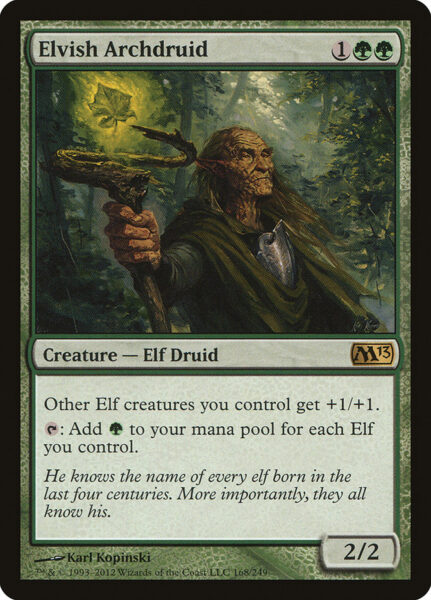
Elvish Archdruid – the OG Elf lord and #2 on my list of Top 10 Mono Green Elf Lords. In most Elfball decks, Elvish Archdruid is kept far away from combat and used, instead, as a source for massive amounts of mana. But have you ever noticed that he’s wearing armor? That he’s girded for battle? In our deck, he can grow himself to epic proportions with just a few Tyvar triggers, making him one of our best attackers. That’s right…that’s a beating stick he’s got in that picture.
Elvish Mystic – a 1-mana creature that taps for . Not overly impressive, but entirely essential to our strategy. Sticking a turn 3 Tyvar with at least one mana still open means our deck is on schedule.
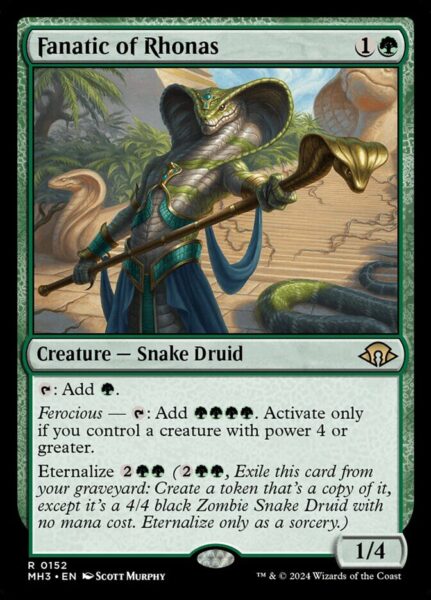
Fanatic of Rhonas – our first and only non-Elf mana dork, it’s at least a Druid and so probably shares something in common with some of our Elves. The reality, though, is this card is simply too good in our deck to pass up. At 2 mana, he fills our curve nicely. He’s got a great body for blocking. And, once we’ve resolved our commander, he can tap for and grow himself to a 5/9. He’s a great target for cards like Seeker of Skybreak, not to mention we can recur him from the graveyard. Wow! That’s a lot! Oh yeah, it’s from Modern Horizons 3. No wonder there’s so much text…
Fyndhorn Elves – speaking of Druids, all of our 1-drop Elves that tap for are members of this tribe.
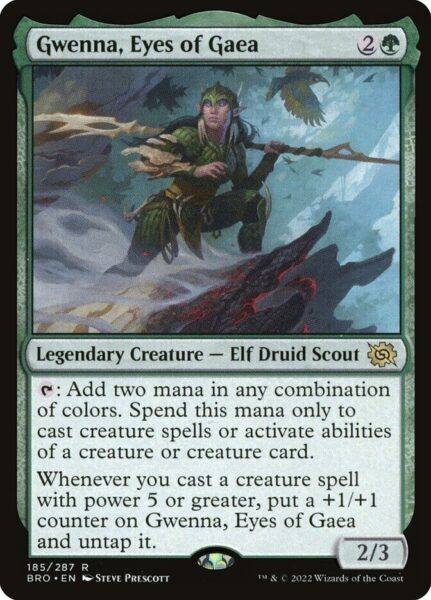
Gwenna, Eyes of Gaea – here’s an example of an Elf I’m excited to play simply because she hasn’t made the cut in any of my other decks and she fits so well here. The 3-drop slot is full of more powerful options in my Selvala, Heart of the Wilds deck and she’s too expensive for my Budget version. For this deck, though, even if we only play two creatures with power 5 or greater, one happens to be our commander. Thus, we can use her to ramp into our commander, untap her on the cast trigger AND put a +1/+1 on her, then grow her to a 5/6 once Tyvar resolves. Not too shabby…
Gyre Sage – another 2-mana Elf that can tap for more than a single , this one needs a little help to do it. Thankfully, we should be able to evolve her consistently at least once with Tyvar, at which point, she’ll grow herself with each tapping for mana. Pretty sweet synergies, if you ask me!
Incubation Druid – another mana dork we’re looking to abuse with the help of Tyvar, we have no plans of jumping through the adapt 3 hoop. Rather, we’ll tap it once and get the counter from our commander, then be able to tap it for 3 mana the rest of the game. Our 0/2 will quickly grow to one of our best threats.
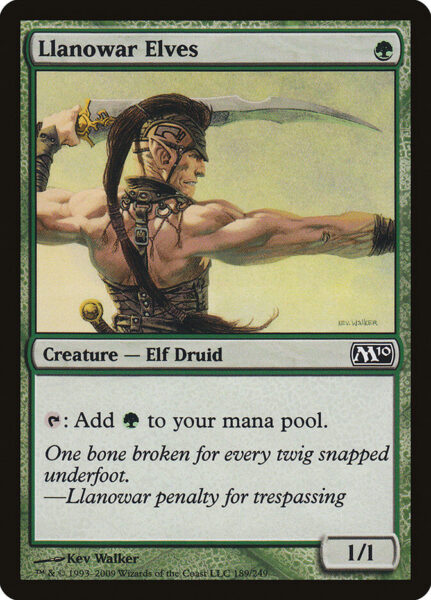
Llanowar Elves – what more can I say about a 1-mana mana dork that I haven’t already said? How about…with muscles like those, I don’t think this Elf should be a lowly 1/1. It’d take a lot of hours in the gym to get that shredded.
Llanowar Loamspeaker – another 2-mana mana dork with a bit of upside, this Elf Druid is unimpressive on its own. However, there are some cute synergies with our commander. After making our land into a creature, we can tap it for mana and put a +1/+1 counter on it. More cute synergies? you demand. Well, with Dionus, Elvish Archdruid on the battlefield, we can tap Llanowar Loamspeaker for mana, grow him to a 2/4 and untap him, then tap him again to turn a land into a 3/3. We can then tap that land for mana, put a +1/+1 on it and untap it, and then attack with a 4/4. If we have Tyvar out, as well, Llanowar Loamspeaker becomes a 3/5 and the 3/3 it makes becomes a 5/5 hasty Elemental creature that will return to being a land, but not lose its counters.
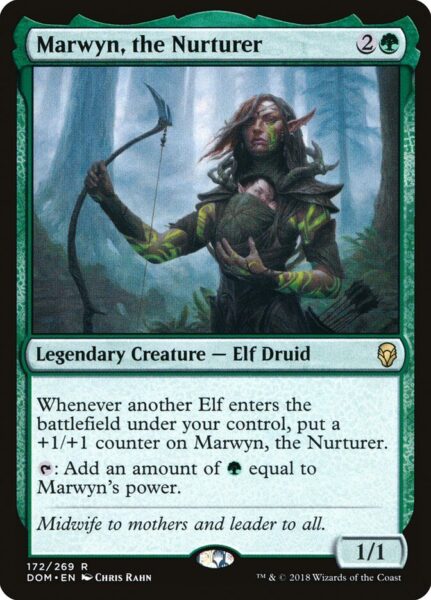
Marwyn, the Nurturer – another great source of many manas. Marwyn may have a baby in her arm, but that’s a bow in the other one and she will bring the beats with a quickness in our deck.
Paradise Druid – this one is here largely to fill our early curve with mana dorks. The hexproof is nice, of course.
Priest of Titania – another Elf Druid that can get big real quick with Tyvar on the battlefield.
Rishkar, Peema Renegade – one of our ways of turning non-mana producing creatures into Llanowar Elves.
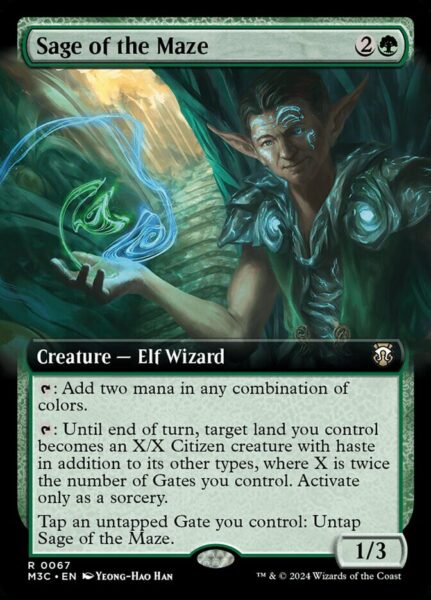
Sage of the Maze – ignore everything after that first line of text. Tapping for two is all we care about and all we’ll ever get from this Elf Wizard. Of course, we could find room for Golgari Guildgate in our mana base, but it doesn’t seem worth it.
Wirewood Channeler – a 4-mana Priest of Titania, at least we get the option of tapping for with this one. We really just want a critical mass of Elves that tap for as much mana as possible, even if we’re paying more than full value for it on the front end.
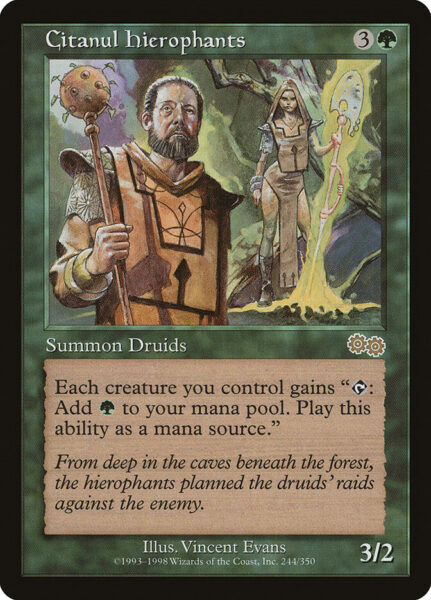
Not a Mana Dork? Not a Problem.
Maybe there’s someone out there who’s made a Tyvar the Bellicose deck with only mana dorks in the creature slot, but that person isn’t me. Nor do I want to pass up on some of the cool Golgari Elf cards available to me now, or the creatures that uniquely synergize with our game plan. However, we also don’t want to lose that sweet, sweet value we get from Tyvar’s static ability. Thus, we’re playing a number of ways (6 to be exact) of turning our creatures who can’t generate mana on their own into mana producers.
A quick note: there are a surprising number of cards that support this aspect of our deck. After several games, however, I realized that we don’t need as many as I originally thought. And, in fact, we could probably cut one or two more, to be honest.
Citanul hierophants – one of the inspirations for the deck, I opened a copy from The List and began forming an idea for a deck, which you can watch here. 4 mana for this effect is kind of a lot, given that it doesn’t do anything else or synergize with our Elves in any way, but I’m hesitant to cut it since it was one of the deck’s build-around cards. I guess I’m sentimental…
Cryptolith Rite – one of the better ways of doing the same thing. For less, we lose the unimpressive body and gain the ability to tap our creatures for a mana of any color. Yeah, this card is strictly better in our deck.
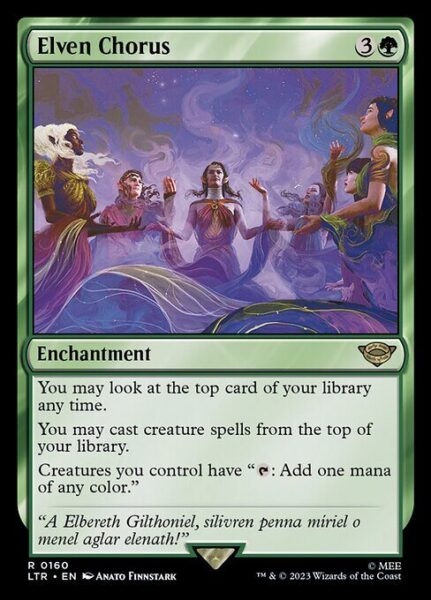
Elven Chorus – as is this card. Conditional card draw is attached to a Cryptolith Rite. Yes, please! By the way, I looked up what the flavor text means and found the following from this site:
O Elbereth Starkindler
(white) glittering slants down
sparkling like jewels
from [the] firmament [the] glory [of] the star-host!
Enduring Vitality – sigh…poor Citanul hierophants. At this point, I’m beginning to think it’s on the short list of first cards cut. This 3-mana 3/3 has strictly better everything.
Rishkar, Peema Renegade – our most limited means of turning creatures into mana dorks, it’s still an auto-include in our deck, given all the Elf and counters-matter synergies.
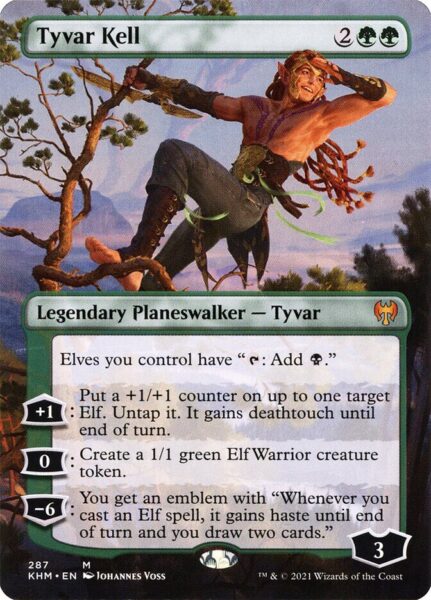
Tyvar Kell – finally! I opened the version pictured above back in 2021 and have only just found a home for it. What a great card for our deck! It turns our various non-mana-producing Elves into mana dorks, this time generating. It supports our counters-matter theme, while also growing our board. Most importantly, though, it allows us to untap a creature, say, like, Circle of Dreams Druid, and make a ton of mana to finish our opponent off with a Drain Life effect. Basically, it does it all for us.
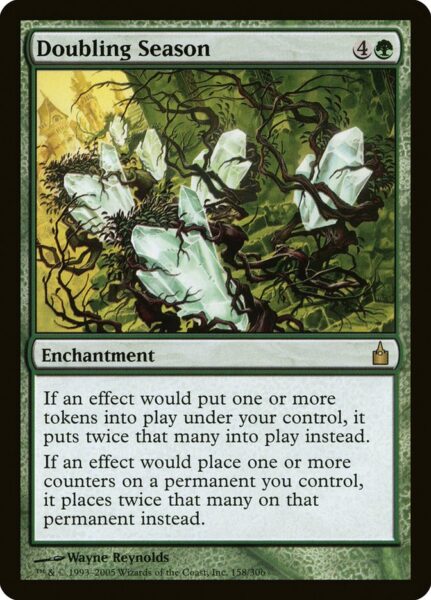
Counter Them Up!
I love putting counters on creatures! I know this based on the number of decks I play that involve counters. At the heart of this love affair is a more abstract appreciation and enjoyment of multi-card synergies. My favorite decks to play are the ones that feature multiple cards, all of which interact with one another, resulting in a sum-is-greater-than-their-parts end game. Hence my love of the Aristocrat archetype. Heck, even my Gruul Dragons deck in Modern shares this trait.
Tyvar the Bellicose is our centerpiece to a similar multi-card strategy that also involves counters. Since we get counters for the amount of mana our creatures generate and since we don’t really want to play this card fairly, we have a variety of ways of taking advantage of this to maximize the power of the counter!
Archdruid’s Charm – okay, our first card in the list barely qualifies, but it does synergize with some of the other counters-matter cards in our deck, while giving us some removal and flexibility. It’s a great card for any deck that plays enough to reliable cast it.
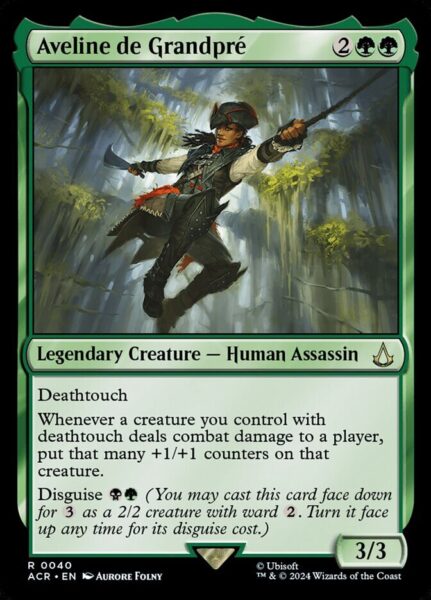
Aveline de Grandpré – I’m stupidly excited about this card for this deck! Yes, it’s not an Elf, but it felt like discovering a diamond in the rough when I found this card in my binder. Of course, it’s not like it’s an old card, so I’m not sure why I was so excited, but still. The deathtouch and counters synergies are too much to pass up for our strategy. That being said, is this card better than Ohran Frostfang, which we aren’t playing? Probably not. We may need to find room for the Snake.
Branching Evolution – when I first built this deck, I had a lot more ways to abuse counters. Cards like Hardened Scales and Ozolith, the Shattered Spire seemed like auto-includes. I won’t fault anyone for including those in this deck, but I have a lot of decks that care about counters, from my G/W Lifegain with Lathiel, the Bounteous Dawn deck to my Hydra Tribal deck with Zaxara, the Exemplary, to name a few. And there are so many cards to squeeze in to the 99, I’ve decided to include only the most powerful. In other words, if it doesn’t double up our counters, it’s likely not here.

Dionus, Elvish Archdruid – one of the inspirations for this deck, this Elf Druid lets us tap all of our mana dorks for mana, grow them with Tyvar the Bellicose (on top of the single +1/+1 counter as part of the ability Dionus grants), untap them and then either do it all again or attack. I’ve played a number of games with this deck and I’ve yet to draw Dionus, Elvish Archdruid. The deck has been very explosive without him/her. I can only dream of the turns I’ll have with this card on the battlefield!
Doubling Season – only the most powerful counter shenanigans, this is the OG.
Evolution Witness – we can play this card fairly, but where’s the fun in that? We’d much rather turn this Elf Shaman Mutant into a mana dork, tap it for mana with our commander out, and get all that graveyard recursion value every turn. Or twice in a turn, if possible!
Gyre Sage – another card we don’t want to play fairly. This card can grow to epic proportions quickly and almost as quickly fuel one of our finishers nearly all by itself.
Incubation Druid – we have zero intention of paying this card’s adapt cost. Notice a trend yet?
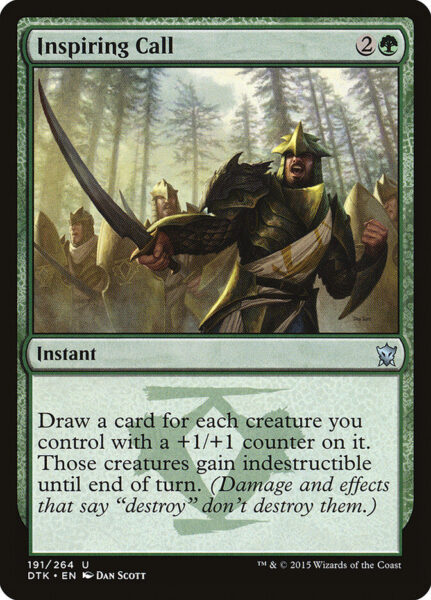
Inspiring Call – the floor on this card is really low (read, dead), while the ceiling has blow-out potential.
Leyline of Abundance – one of our more greedy cards, this 4-mana enchantment is still pretty good in our deck, even when not in our opening hand. Getting an extra counter on each creature that taps for mana is decent and the first reason I thought to include this card. The second part gives us a late-game mana sink that grants us some inevitability.
Marwyn, the Nurturer – another Elf that can produce enough mana by itself to kill an opponent with one of our finishers.
Rishkar, Peema Renegade – sometimes we just need to get a few counters on something to get the party started, even in a deck not totally looking to abuse counters.
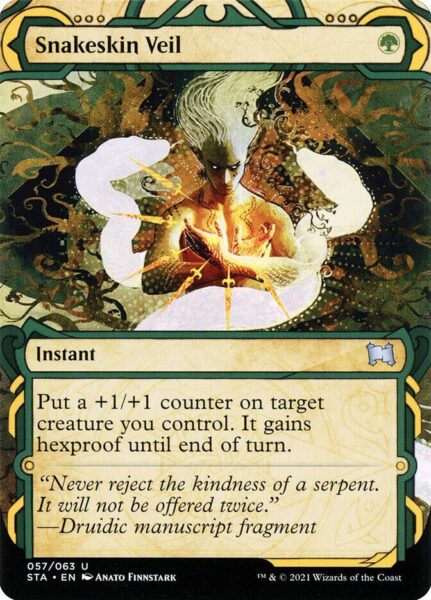
Snakeskin Veil – my playgroup has been trending more and more to protection spells and who am I not to jump on the bandwagon! Seriously, when playing French Commander, these kinds of cards gain a lot more value. And, of course, we get a +1/+1 counter out of nerfing a kill spell, making this the obvious choice over something like Vines of Vastwood.
Tyvar Kell – not only does this Tyvar put a +1/+1 counter on a creature, he untaps it, meaning he’s best friends with cards like Elvish Archdruid, Circle of Dreams Druid, and our many other Elves that can tap for a bunch of mana by themselves.
Vastwood Fortification – it’s a land or a spell, making this granter of a single +1/+1 counter an auto-include.
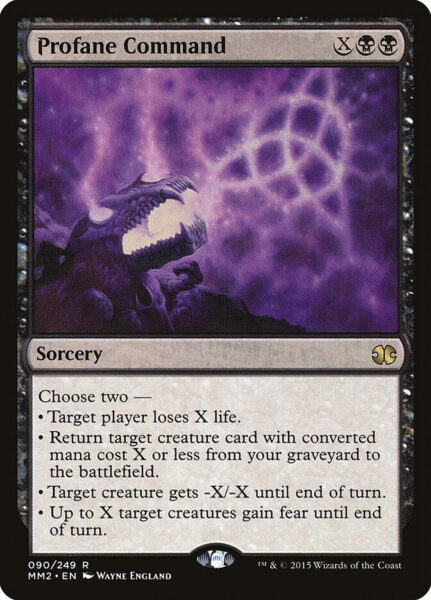
Who Needs Combat? Our Finishers
I’m including in this section both the cards we cast to kill our opponent outside of combat and the cards that aren’t mana dorks that support this strategy. The former can’t happen without the latter.
Making all the manas
Mana Reflection – if we’re tapping our Elvish Archdruid for 8 mana, it’s strictly better to tap it for 16, right? In case it’s unclear, doubling up our mana also doubles up the number of counters we put on our mana dorks with our commander out. This card costs a whopping and could be considered win-more, but I envision it coming down late and ending the game the same turn.
Seeker of Skybreak – there are a number of cards that allow you to untap creatures, but this one is an Elf and comes down as early as turn 2. She functions early as a pseudo-Llanowar Elves and late as fuel for our finishers. Also worth noting is that we can untap one of our creatures before blocks and ambush our opponent.
Seedborn Muse – one of our few non-Elves, this Spirit allows us to trigger Tyvar on our turn and on our opponent’s turn, which should set us up to close out a game nicely.
Timberwatch Elf – printed back in 2003, this card would probably cost only if printed today. Still, it’s worth the cost in our deck. It serves a dual purpose for us. First, it can pump an unblocked (or trampling) Elf to punch through lethal damage. But, much more fun, it can make Marwyn, the Nurturer massive, which then allows her to tap for a ton of mana so we can kill our opponent with Drain Life. Combo, wombo!!!
Tyvar, Jubilant Brawler – giving all of our mana dorks pseudo-haste is great, but it’s his +1 that will win us the day more often.
Tyvar Kell – playing all the Tyvars makes my soul happy! Plus, this one untaps one of our mana dorks, as well.
Wirewood Lodge – for a single , we can untap our pumped up Marwyn, the Nurturer in the above scenario and make even more mana.
Using all the manas
Drain Life – the OG Black burn spell, this one can finish off one opponent, while putting our life total out of reach of the remaining ones.
Exsanguinate – Drain Life got the Commander treatment. What’s better than draining and gaining one opponent? Draining and gaining each!
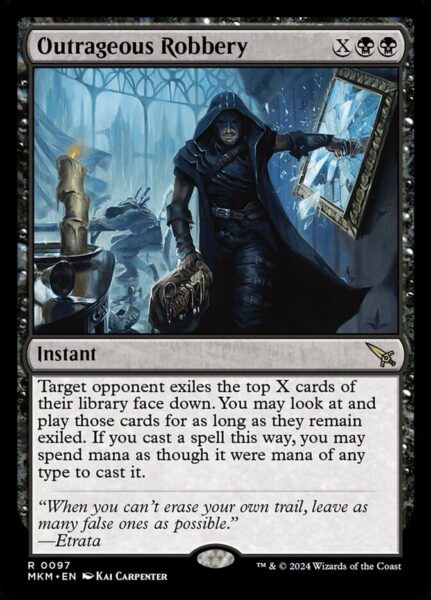
Outrageous Robbery – another card I’m stupidly happy about. Sure, it’s probably unlikely that we’ll be able to mill our opponent out with this spell, though it is certainly not outside the realm of possibility. But I just can’t resist the chance to steal 40+ cards from our opponent’s deck. It may not win us the game, but it’s going to be fun!
Profane Command – we can drain one opponent out with this card, while simultaneously making our team of Elves potentially unblockable to kill another. It does some other things that are relevant, too, making this card one of our best finishers.
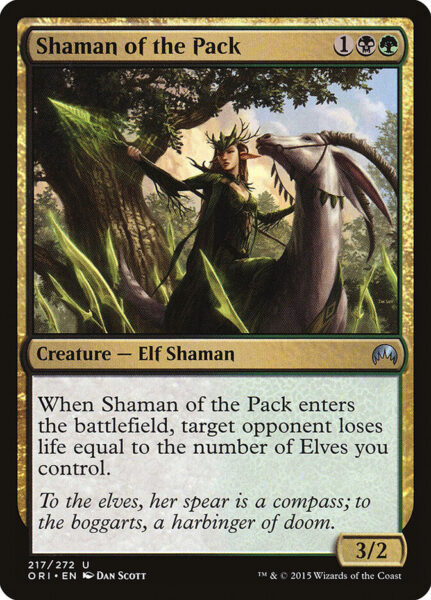
Burn ’em out a different way
Being in gives us access to some Elves that can drain our opponents, as well. These are the two best.
Lathril, Blade of the Elves – our deck provides a LOT of combo potential with this Elf Noble. With both deathtouch and menace, our opponents will be doubly disincentivized to block, meaning we’ll likely get a bunch of 1/1 green Elf Warrior tokens. And, assuming we have one of our ways to make all of our creatures into mana dorks, we can use these tokens to fuel our Drain Life effects, or win with Lathril’s own ability. Throw in Dionus, Elvish Archdruid and we’re looking at draining and gaining for 20 a turn, while also growing our team.
Shaman of the Pack – if you’ve followed my site and YouTube channel for awhile, then you know how much I love the Aristocrat archetype. It will come as no surprise, then, that I’ve longed to play this card in an Elf deck. This 3-mana 3/2 is best in the late game on a stalled board.
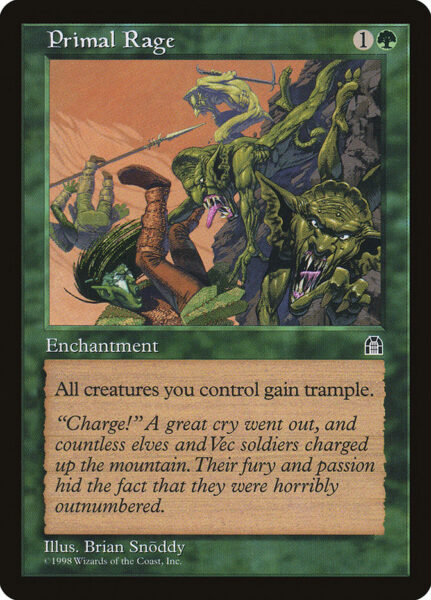
Who Needs Combat? Well, Sometimes We Do.
As much fun as it is to win without combat, there will be plenty of games when we will need or want to win by beating face. Thankfully, our commander does an extremely good job of transforming our army of unimpressive mana dorks into an elite fighting force. Still, he could use a little help, particularly if our opponents keep killing him. With this in mind, we play ways to punch through damage on a clogged board and a small(ish) package of Elf Lords that can grow our team on their own.
Trample
Nothing makes me sadder than painstakingly growing a team of 1/1s into massive threats, only to have them get chumped blocked for days by Goblin tokens. These are the cards that help us avoid that scenario.
Ezuri, Renegade Leader – the OG Mono Green Elf commander, this Elf Warrior does it all for us. He protects our pieces, while presenting a lethal and repeatable Overrun effect. Yes, I play Ezuri in my Selvala, Heart of the Wilds deck. No, I don’t feel bad about it.
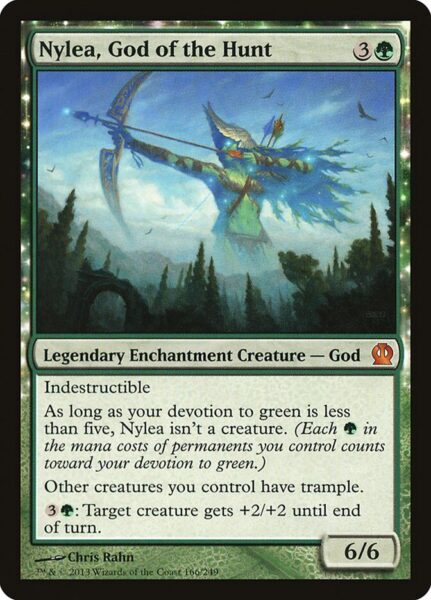
Nylea, God of the Hunt – the original God cycle was amazing when it first came out and it still holds up today. We shouldn’t have a problem making Nylea into a creature, but we mainly want that third line of text. The late-game mana sink she offers is icing on the cake.
Primal Rage – a card I think is woefully underplayed in Commander, it appears in only 1% of decks according to edhrec.com. It’s very fairly priced at and makes blocking for our opponent extremely difficult.
Elf Lords
Canopy Tactician – gives other Elves +1/+1 while tapping for . This is our kind of Elf Lord!
Elvish Archdruid – this one is strictly better than Canopy Tactician.
Ezuri, Renegade Leader – not a traditional Lord insomuch as he does not buff our team as a static ability, but he does give us a repeatable Overrun effect that can win us games all by itself.
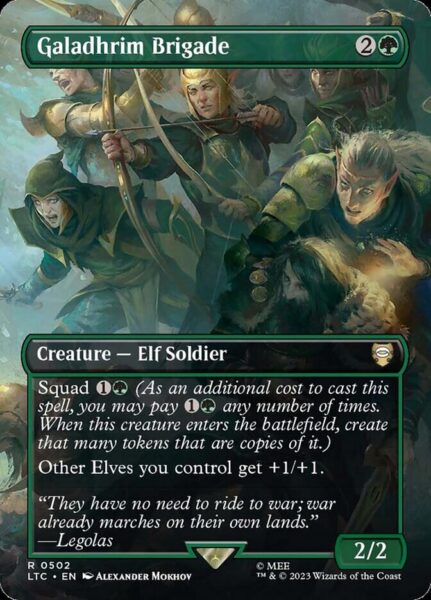
Galadhrim Brigade – what a card! It’s an Elf Lord that brings other Elf Lords with it. In the late game, we should easily be able to spend between 10 and 20 mana on this card, making it a legitimate game-ender the turn we resolve it if we have a small army already assembled.
Leaf-Crowned Visionary – my pick for #1 Elf Lord, this Elf Druid grows our team while ensuring we don’t run out of gas.
Timberwatch Elf – our second non-Lord, this Elf will cause massive headaches for our opponent, as a single unblocked 1/1 could become lethal before damage is dealt.
The Rest
The remainder of our deck is made up of card draw, utility creatures, kill spells, tutors, and protection spells. This is the place I’d start cutting from if there is a card or cards you really want to play. With access to , we could easily play Demonic Tutor over Chord of Calling or just play both. And is a card like Reclamation Sage really necessary when we can (and do) play Assassin’s Trophy?
My choices for these cards are primarily guided by theme and what I play (and don’t play) in other decks. Thus, Miara, Thorn of the Glade gets the nod over any number of Black card draw spells because she’s an Elf and I’ve never played her before. Similarly, I’m playing Setessan Tactics over a hard sweeper because of its synergies with the deathtouch our attacking creatures gain from Tyvar.
Flex Spots
Beyond trimming a kill spell or a protection spell from The Rest section, here are the first cards I would consider cutting when looking to add the new hotness or to shore up a weakness:
Citanul hierophants – given the number of creatures who tap for mana we already play, this kind of effect can be a dead draw for us. And, 4 mana is a lot for a creature who doesn’t synergize with our Elves.
Inspiring Call – as mentioned above, sometimes this will be a dead card. There are other ways to draw cards or protect our team that aren’t so conditional.
Leyline of Abundance – is a lot to grow our team a single +1/+1 counter at a time, while the static effect is also kind of slow. Another Elf Lord or something like Hardened Scales would be more impactful for less mana investment.
Mana Reflection – I just want to win with this card once and then I’ll decide if it’s worth the spot in our deck. The potential is so, so appealing. But is it a siren song?
Miara, Thorn of the Glade – we have access to much more efficient and unconditional ways to draw cards, but this is my first time playing an Elf deck with Black as one of its colors. I’m going to try this card out for now.
Reclamation Sage – we aren’t taking as much advantage of our creature type as my Mono Green Elf deck does, so I could see cutting this in favor of a more flexible removal spell.
Snakeskin Veil – are protection spells that only have a single target worth playing? That’s for you to decide within your own meta.
Notable Omissions
Cabal Coffers – we are playing Urborg, Tomb of Yawgmoth, but without it on the battlefield, I don’t think we’d be able to abuse Cabal Coffers enough to warrant its inclusion.
Craterhoof Behemoth – how many decks can you have with Craterhoof Behemoth as a finisher before it’s too many? I think I have three currently and that seems like enough.
Nykthos, Shrine to Nyx – nearly 10 years ago, I sold two foil copies of this card… The price is about the same as then, but I miss having the extra copies to put in my various decks. If you have it, play it.
Selvala, Heart of the Wilds – once I get another copy, I’ll find room for this powerful enabler. Play her if you got her!
Yavimaya, Cradle of Growth – another land that should be included. I just don’t have an extra copy.
Ideal Hand and Game Play
In our opening seven, we want no more than three lands, two mana dorks (at least one 1-drop), some kind of card draw, and either a kill spell or a way to abuse counters. We don’t really want to see one of our finishers, while we’re also happy to see a card that turns all of our creatures into mana dorks. Two lands and three mana dorks is also perfectly acceptable, though we do want to make land drops in the early game especially. Regardless of how much mana we can produce, I’ve found while playing the deck that we kind of always want more.
We would love to be in a position to untap with Tyvar the Bellicose on turn 4 and immediately begin growing our team of underwhelming mana dorks so that we can begin pressuring our opponent’s life total or win in combat. We really want to have at least one of our creatures that can tap for more than one mana ready to go at this point, as well.
Weaknesses
Like any synergistic creature strategy that leans heavily on ramp, we can draw the wrong half of our deck. Of course, Tyvar the Bellicose in the command zone means we are always happy to have mana dorks on the battlefield. However, without the proper support, they can still grow too slowly to be competitive.
Sweepers can also hurt us if we’ve had to overextend or been unlucky flooding out. If we have gotten some card draw online, then we are less hurt by a boardwipe. If you have Phyrexian Arena in your opening 7 with the ability to cast it, then that’s a snap keep.
The biggest and most unexpected weakness is also the most obvious: if we’re growing our team of mana dorks, then that means we’re tapping them for mana, rather than attacking with them. I’ve noticed this being the biggest tension within the deck, seconded only by not having a way to generate a lethal amount of mana. Dionus, Elvish Archdruid is one of our best cards precisely because it solves both of these problems.
Thus, you’ll find yourself facing the decision of growing your team on your turn and advancing your board, but not attacking or having blockers, or attacking and not advancing your board as much as you would like, or holding back blockers and growing you team on your opponent’s turn, but at the cost of not advancing your board otherwise.
This is the most interesting dilemma of the deck and one that you’ll need to master to play the deck at its potential.

Conclusion
Like most Elfball strategies, this deck will spend a lot of its early turns committing unimposing creatures to the battlefield before sticking one of its powerful enablers, whether it be Dionus, Elvish Archdruid, Lathril, Blade of the Elves, Ezuri, Renegade Leader, or Galadhrim Brigade and winning in one turn. And we didn’t even mention getting to untap with Tyvar the Bellicose on the battlefield.
And that’s one of the most fun and most powerful aspects of the deck – we don’t need our commander to win. We play enough creatures to go wide and enough lords to go big, while we have enough enablers, many of which are premier Elf Tribal commanders in their own right, that we have many pathways to victory. And we could further increase our odds of winning without Tyvar the Bellicose if we included cards like Craterhoof Behemoth, which I play in several other decks and so have purposefully left out of this one.
This deck is super fun to play, precisely because it has so many ways to win. So, if you like creature strategies that look to use synergies between themselves to build an overwhelming force, but also want some alternate win conditions outside of combat, then give this deck a try! Is Tyvar the Bellicose the best Golgari Elf commander out there? I’ll let you be the judge, but I really like both the deck he incentives us to build around him and the play patterns that come from it.
As always, thanks for reading and watching!
